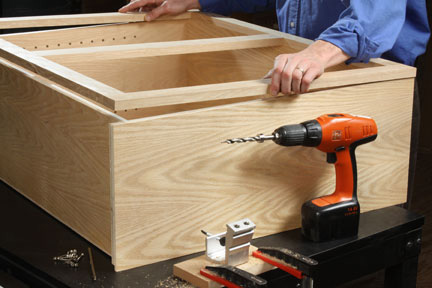
Trim out a cabinet the classic way using pocket-screw joints.
Face frames provide attachment points for door hinge and latch hardware, while hiding the front edges of the cabinet box. They can also help correct minor plywood bowing and give you a means of fitting one cabinet against its neighbor. You can use a variety of joinery options for making face frames, including dowels, mortise-and-tenons or even small biscuits, but none of these alternatives are as fast as pocket screws. With a simple jig, making a pocket-screw joint is simple: Drill a pair of stopped holes and drive two self-tapping screws to lock the joint. Here’s how to dress up your next cabinet project with a pocket screwed face frame.
Step 1: Joint and plane stock for your face frame parts so the stiles and rails
will be flat and square. Face frame components are typically between 1 1/2 and 2
in. wide. Rip the rails and stiles to the width you desire, and leave the
workpieces overly long so you can cut them to exact length as you build the frame.
The outermost stiles should run the full height of your cabinet, with the top and
bottom rails fitting in between them. Any intermediate stiles, such as for the door
divider we’ll show here, should fit between the top and bottom rails.
Step 2: Measure the height of your cabinet carcass, and crosscut the outer stiles
to length. An easy way to find the exact length of the top and bottom rails is to
set the stiles together and so they’re lined up with the outside face of the
cabinet side. Use a long rule to measure from the stiles over to the opposite edge
of the cabinet (see Photo 1). Add 1/4 in. to this measurement; the extra length
will make your face frame overhang the edges of the cabinet by 1/8 in. to give you
a little “wiggle” room when installing it and, if necessary, scribing it to an
adjacent cabinet. Cut the top and bottom rails to length.
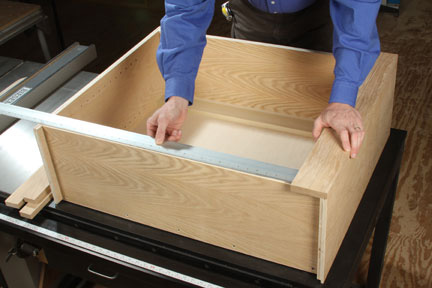
Step 3: On a large worksurface, set the rails and stiles face down and into
position. Measure for any intermediate divider stiles or other rails. Cut those
pieces to length as well. Dry-fit the entire face frame together, and label both
parts of each joint with letters or hash marks so you can keep their orientation
clear. It’s also helpful to mark an arrow on each joint to show which piece will
receive the screw pockets and which direction to drive the screws (see Photo 2).
The easiest joints to drill are those with screws driven through the ends of one
joint part and into the edges of the mating part. On the face frame shown here,
we’ll drill the ends of the rails and door divider.
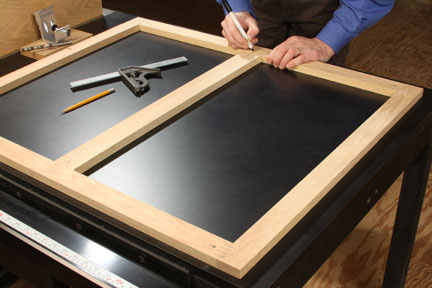
Step 4: Making a pocket-hole joint involves boring a pair of steeply pitched holes
into one workpiece with a special stepped drill bit. Set the drilling depth by
tightening a stop collar on the bit (see Photo 3). The instructions that come with
your pocket-hole jig will explain where to tighten this collar, based on the style
of the jig. This General Tool’s version also recommends fastening the jig to a scrap
base so you can clamp it to your worksurface.
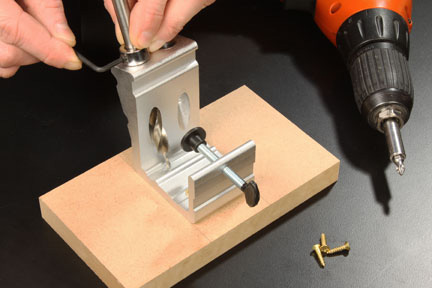
Step 5: Drill pairs of pocket holes into the marked faces of the parts you
identified in Step 3 (see Photo 4). To keep the drill bit from clogging, drill each
hole in a couple of plunging passes, pulling it back out of the jig holes to clear
the chips.
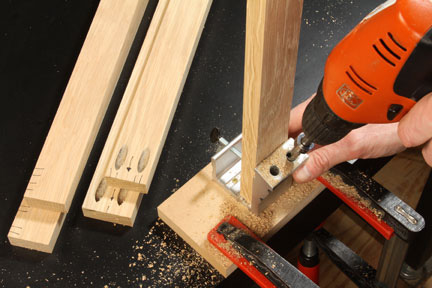
Step 6: Assemble the face frame parts by driving self-tapping face frame screws
down into the screw pockets and across the joints (see Photo 5). There’s no need to
drill pilot holes in the mating parts first. Be sure to use plenty of clamps to
hold each joint securely together: the screws sometimes push the workpieces apart
as they tap their holes. A locking face-frame clamp (silver in photo) is
particularly useful for this job. Note: You can reinforce pocket-screw joints with
glue as well, although this isn’t mandatory.
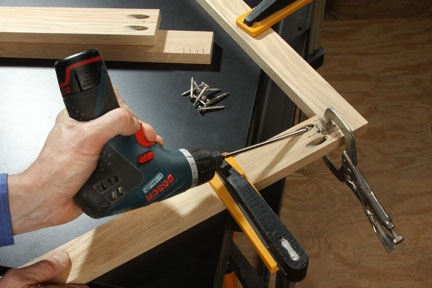
Step 7: Plane, scrape or sand the back face of your assembled face frame to flatten
any minor mismatching at the joint seams. If you’re planning to use typical
mortised butt hinges, now is a good time to cut the mortises in the stiles. You
should also decide how you’ll fasten the face frame to your cabinet. You can use
glue alone or in conjunction with dowels or biscuits to make the connection
invisible. Pin nails or 18-brads also work nicely, if you don’t mind puttying over
the nail heads and seeing those tiny spots on the finished cabinet. Set the face
frame on the cabinet and adjust it for an even overhang on the stile edges. Use
plenty of clamps to secure it in place. As you tighten the clamps, you can push or
pull the carcass top, bottom and sides a little bit to adjust for any minor bowing
that may be present. Drive the fasteners (see Photo 6).
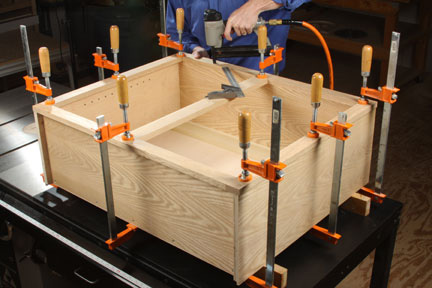
Step 8: Since the cabinet shown here will be stand-alone, we’re choosing to trim
off the stile overhangs for a flush fit. A router and piloted flush-trim bit make
this process quick and easy (see Photo 7).
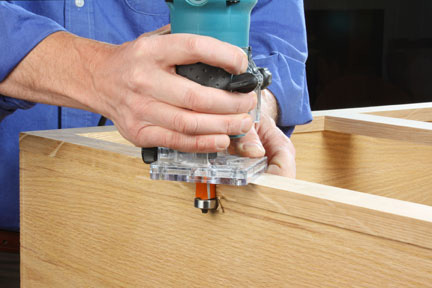
There you have it: a traditional cabinet detail made with the convenience of modern
jig joinery.





